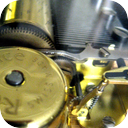(short preview of full seamless looping track)
(short preview of full seamless looping track)
(short preview of full seamless looping track)
(short preview of full seamless looping track)
(short preview of full seamless looping track)
Slow Music Box
This product is not available in the selected currency.
In Stock
Backordered
Out of Stock
Description
The babies all slumber, safely in their beds, basking in the radiance of youth and the absolute security that someone somewhere is making life safe and comfortable. The sweet tones of the metal music remind the adults of days gone by when all the world was simple and there were no worries or fears fluttering in the backs of their minds, keeping their smiles from being full and naturally proud. A music box is a 19th century automatic musical instrument that produces sounds by the use of a set of pins placed on a revolving cylinder or disc so as to pluck the tuned teeth of a steel comb. They were developed from musical snuff boxes of the 18th century and called carillons à musique. Some of the more complex boxes also have a tiny drum and small bells, in addition to the metal comb. The original snuff boxes were tiny containers which could fit into a gentleman's waistcoat pocket. The musical boxes could have any size from that of a hat box to a large piece of furniture, but most were tabletop specimens. They were usually powered by clockwork and originally produced by artisan watchmakers. For most of the 19th century, the bulk of musical box production was concentrated in Switzerland, building upon a strong watchmaking tradition. The first musical box factory was opened there in 1815 by Jérémie Recordon and Samuel Junod. There were also a few manufacturers in Bohemia and Germany. By the end of the 19th century, some of the European makers had opened factories in the United States.
Opps
Sorry, it looks like some products are not available in selected quantity.



